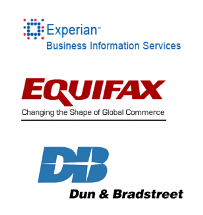Business Credit Score Rating
Last week we explored your D&B number, its importance, and how to obtain one. This week we’ll look at business credit scores and what drives them. 
Let’s face it; business credit score ratings can be confusing. Each business credit reporting agency uses various metrics in calculating its business credit scores. For example, Dun & Bradstreet uses up to 875 payment experiences to generate a company’s PAYDEX® Score and up to 80 payment experiences are reported in your business credit report.
So without getting into all the various scoring models, formulas, historical analysis and all that jazz, let’s talk about what you can do on a company level to maximize your business credit scores.
Here are five main factors that drive your business credit ratings:
1) Company profile – the profile and records of your business plays a crucial role in how lenders assess the viability of your company. A combination of factors such as financials, registrations, years in business, industry classification, and company size play a key part during risk assessment. For example, business credit agency, Dun & Bradstreet, assign a “5A” to “HH” rating classification to reflect a company’s size based on worth or equity. This rating is assigned only to companies that have supplied financial statements to D&B.
If you look at how Equifax Small Business returns detailed information on your business report it provides registrations, filing dates, incorporation date, registry number, and the status of your business on record with the Secretary of State whether its active or inactive.
So it’s important that all your business documents, financials, filings, and registrations are up to date and complete in order for your business credit report to reflect up to date and accurate information for creditors to view.
2) Payment history – your company’s payment experiences show how the bills are paid in relation to the terms your company has with suppliers, creditors, and lenders. While each business credit reporting agency utilizes various reporting metrics; age, activity, and payment history play the largest role in your business credit ratings.
Other than paying all your invoices on time, it’s important to use your credit on a regular basis. A consistent trend of purchases and timely payments is what establishes a positive payment history.
3) Credit limits – having sizable individual and combined credit limits extended to your company afford you the chance to obtain even higher limits from other lenders. Credit limits clearly show what level of risk creditors are willing to extend to your business. It is also a useful starting point for new lenders when determining what amount of credit to extend to your company.
4) Credit utilization ratio – while the size of credit limits show what amount of credit your creditors are willing to extend to your business; your debt to credit utilization ratio shows how well your company manages its. In my opinion keeping your business debt to credit ratios at 50% or below on individual accounts and overall is ideal.
5) Credit diversity – the types of credit your business has reporting plays a significant role in your overall creditworthiness. Having net 30-60 day term accounts, revolving accounts, installment accounts, and open accounts all play a crucial role. A diversity of credit account types shows creditors that your company can handle various forms of financing responsibly.
Keep in mind your business credit scores will tend to fluctuate with each agency so it’s important to monitor your files regularly. In addition, each business credit report will be different with each agency. This occurs because the business credit agencies do not share data and not all creditors, suppliers, and lenders share data with all three agencies. One supplier may submit data only to D&B while another lender may share data only with Corporate Experian.
Ready to start building your business credit scores? Become a member of my Business Credit Insiders Circle and gain access to a proven step-by-step business credit building system. A system that provides you access to vendor lines of credit, fleet cards, business credit cards with and without a PG, funding sources and lenders that report to all the major business credit bureaus. Submit your name and email below for details and receive a free business credit building audio seminar ($597 value) =>
To Your Success In Business and in Life!
Did This Blog Help You? If so, I would greatly appreciate if you like and shared this on Facebook.
About the author
 Marco Carbajo is a business credit expert, author, speaker, and founder of the Business Credit Insiders Circle. He is a business credit blogger for Dun and Bradstreet Credibility Corp, the SBA.gov Community, About.com and All Business.com. His articles and blog; Business Credit Blogger.com, have been featured in ‘Fox Small Business’,’American Express Small Business’, ‘Business Week’, ‘The Washington Post’, ‘The New York Times’, ‘The San Francisco Tribune’,‘Alltop’, and ‘Entrepreneur Connect’.
Marco Carbajo is a business credit expert, author, speaker, and founder of the Business Credit Insiders Circle. He is a business credit blogger for Dun and Bradstreet Credibility Corp, the SBA.gov Community, About.com and All Business.com. His articles and blog; Business Credit Blogger.com, have been featured in ‘Fox Small Business’,’American Express Small Business’, ‘Business Week’, ‘The Washington Post’, ‘The New York Times’, ‘The San Francisco Tribune’,‘Alltop’, and ‘Entrepreneur Connect’.